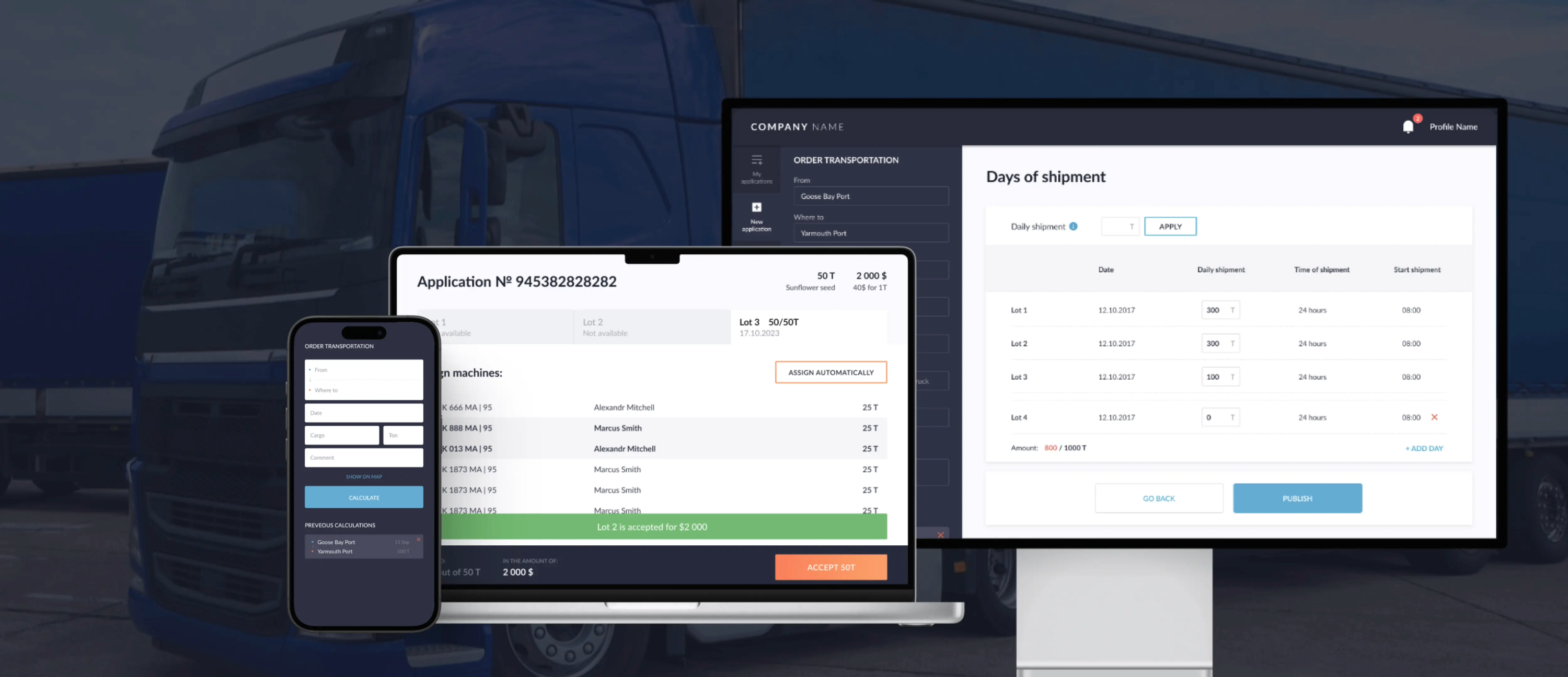
Сучасне життя дуже динамічне і сповнене викликів, оскільки люди намагаються балансувати кар'єру, друзів та стосунки. Зі смартфонами, які завжди під рукою, онлайн-знайомства знову на підйомі, і Tinder з його 50 мільйонами користувачів мабуть, є найпопулярнішим застосунком для знайомства з новими людьми сьогодні. Як він створений і як ваш стартап може навчитися у Tinder та знайти своє місце під сонцем? Ми ділимося деталями про те, як розробити додаток, схожий на Tinder, і скільки це коштує.
Ви можете дізнатися Послуги електронної комерції та маркетплейси
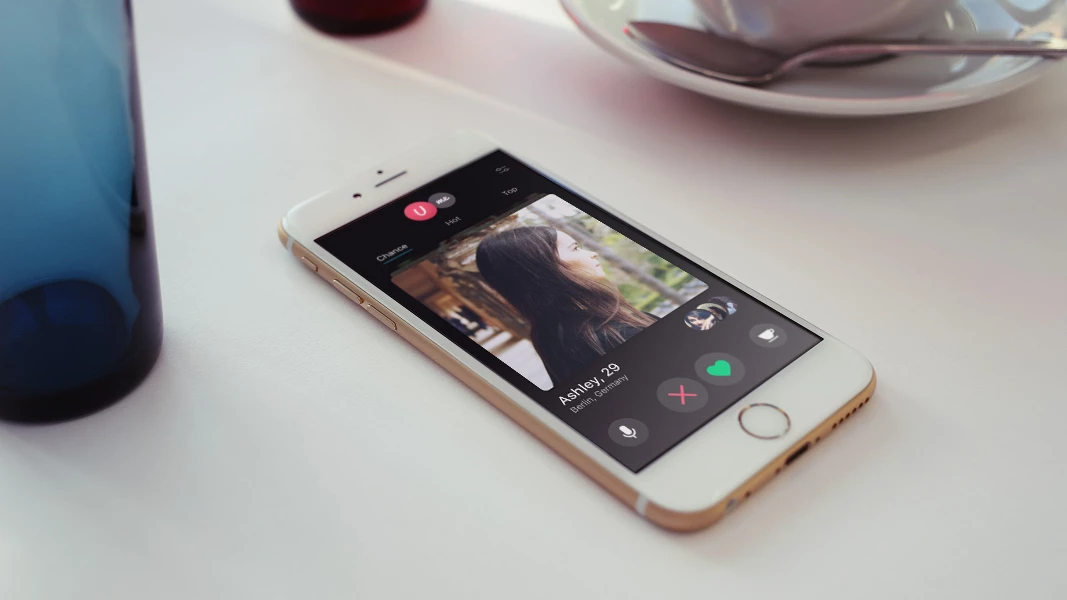
Звичайно, з великою кількістю додатків для знайомств і соціальних мереж, перше, про що вам слід подбати, це оригінальна ідея вашого альтернативного додатку для знайомств. Ви можете подумати про:
- Цільова аудиторія. Вона не повинна бути занадто широкою або занадто вузькою. Сам Tinder орієнтувався на технічно підкованих міленіалів, що є трохи занадто широким, але додаток став піонером у переосмисленні онлайн-знайомств. Додатки, подібні до Tinder, такі як She та Grindr, фокусуються на сексуальних меншинах, а Pure є одним з простих додатків для швидких зустрічей.
- Варіація вже існуючої ідеї. Не обмежуйтеся лише онлайн- та мобільним світом! Наприклад, додаток для знайомств Hinge базується на практиці, яку люди використовували протягом років для пошуку партнерів — просити друзів познайомити вас з кимось. Щоб стати кращим за Tinder, вам потрібно робити те, що він робить, тільки краще і з оригінальним поворотом.
- Монетизація. Думки про монетизацію стартапу — це те, чого ви точно не можете уникнути, ви також можете почати з цього і генерувати ідеї звідси. За що користувачі будуть готові платити? За дзвінки? За зміну думки? За побачення з знаменитістю? Ми впевнені, що є багато ідей для додатка, схожого на Tinder, які ви можете використати, щоб виділити своє рішення.
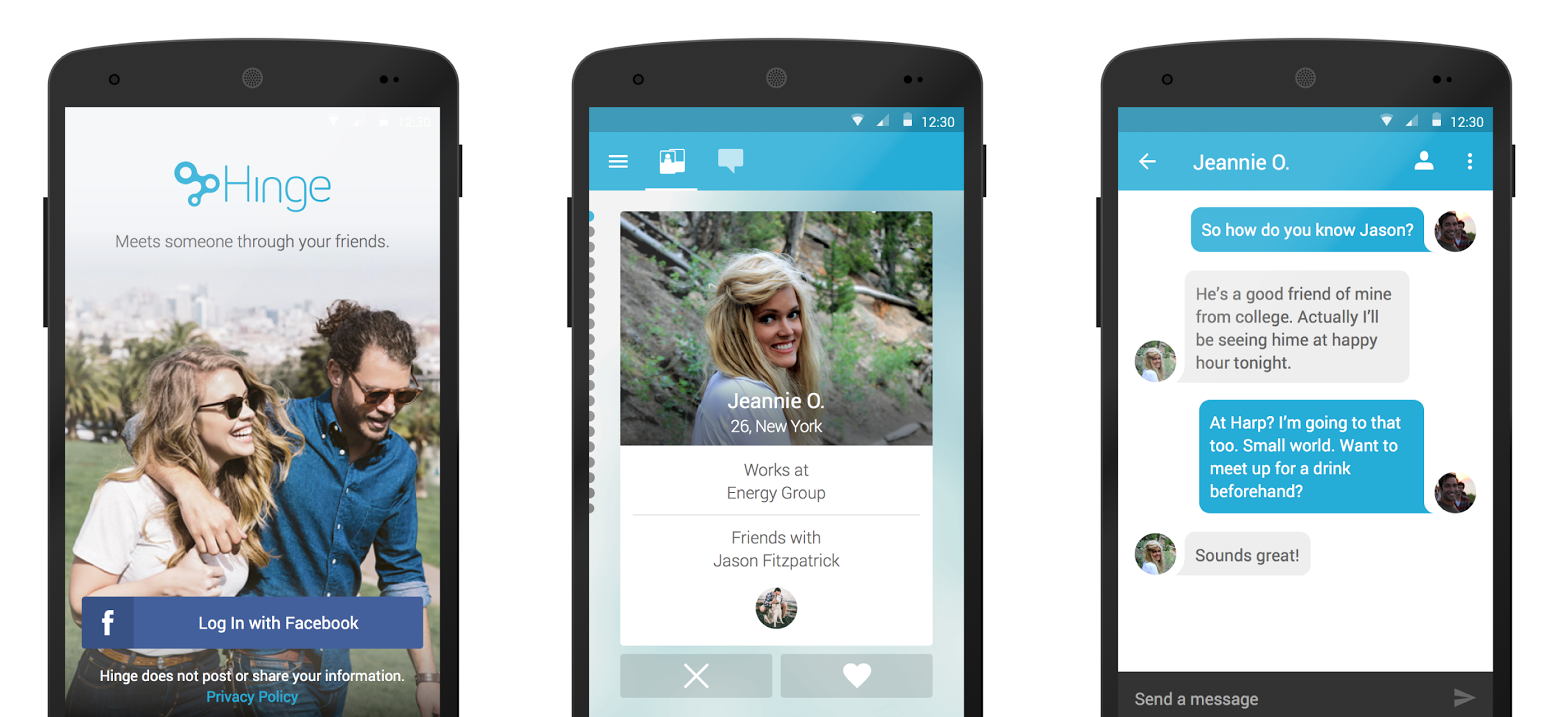
Є чудова ідея для додатку, схожого на Tinder? Давайте дізнаємося, як виглядає наступний процес розробки Tinder:
Основні елементи додатків для знайомств, схожих на Tinder
Коли ви завантажуєте додаток з Google Play або App Store, ви бачите його як єдиний продукт, але створення Tinder насправді включає три основні компоненти, кожен з яких створений окремим професіоналом або групою:
- Дизайн
- Сам додаток (iOS, Android або обидва)
- API
Перед початком розробки необхідно провести зустріч або дзвінок через Skype з вашою віддаленою командою розробників, щоб уточнити всі деталі та обговорити структуру застосунку. На основі цієї інформації готується технічна документація. Наприклад, UME — новий застосунок, схожий на Tinder, який ми створили, має два розділи: U та Me, пошук з різними фільтрами, гарячі та топові списки, екран оцінок, запрошення на побачення, текстові та голосові повідомлення, доступні користувачам, які провели праворуч один на одного.
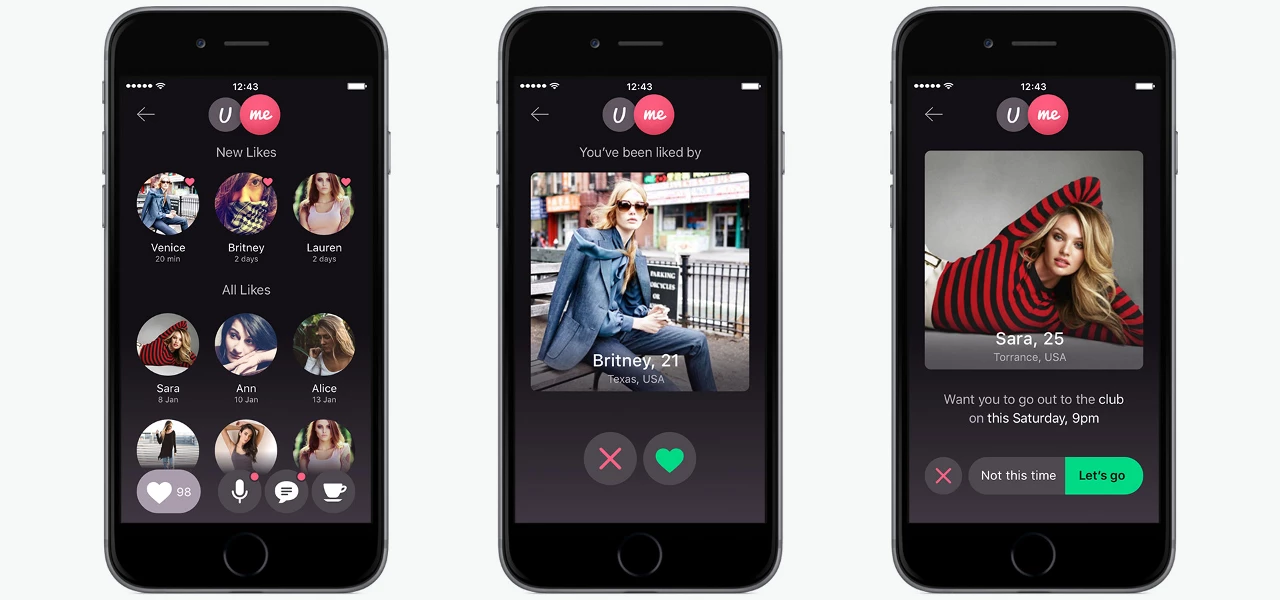
Після того, як ви визначитеся зі структурою застосунку, дизайнер приступає до створення макетів для всіх екранів вашого застосунку. Ці макети передаються мобільним розробникам, які перетворюють їх на реальний застосунок. Оскільки кожен застосунок працює з даними, постійно їх зберігає, змінює та видаляє, застосунок також потребує серверної частини (API), яку обробляють бекенд-розробники Tinder.
Говорячи про основні функції, застосунок, схожий на Tinder, повинен мати:
- Реєстрація
- Профілі користувачів
- Фільтри
- Супутність
- Події в реальному часі
- Платні функції
Реєстрація
Facebook, Twitter та Google вже стали трьома найпопулярнішими варіантами швидкої реєстрації для багатьох веб-сайтів та застосунків для Android та iOS. Оскільки люди, які шукають партнера, зацікавлені у знаходженні інших справжніх людей, Facebook або інша подібна мережа, популярна у вашій країні, є найкращим вибором. У альтернативі Tinder під назвою UME ми використали як Facebook, так і реєстраційні опції VK (російський Facebook). Але більшість застосунків, схожих на Tinder, для Android та iOS пропонують Facebook як єдиний варіант реєстрації. Тільки застосунок OkCupid покладається на реєстрацію через електронну пошту.
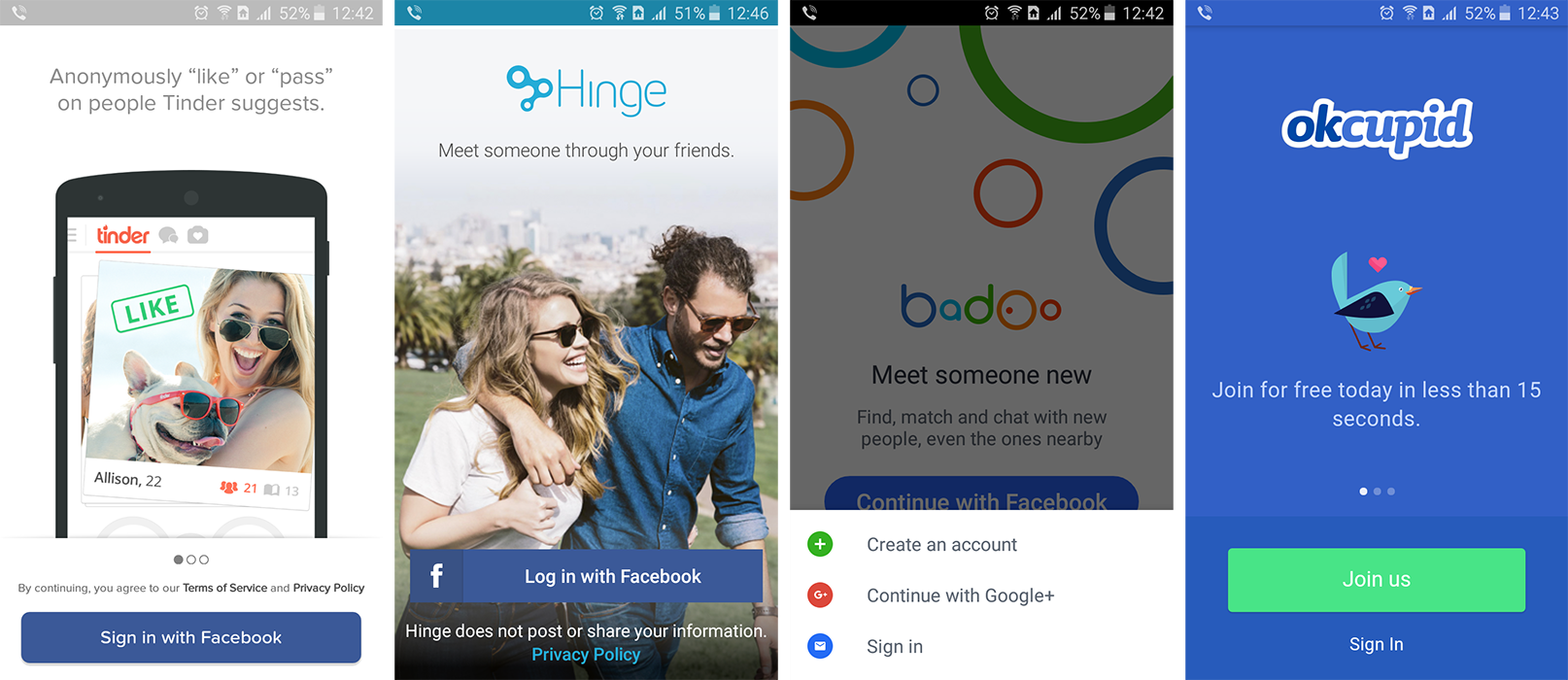
Наша команда Android розробила зручну бібліотеку SocialAuthHelper для реалізації реєстрації через соціальні мережі.
Профілі користувачів
На початку ери онлайн-знайомств такі сайти, як Match.com, Plenty of Fish та OkCupid, пропонували довгі анкети та детальні профілі користувачів, що вказували все — від астрологічних знаків до діапазону річного доходу. Але в наш час люди читають все менше, а веб став більш візуальним. Тому три основні компоненти профілю користувача в застосунку, схожому на Tinder, будуть:
- Фотографії користувача
- Вік
- Місцезнаходження (визначається за допомогою GPS або даних, отриманих з Wi-Fi мережі)
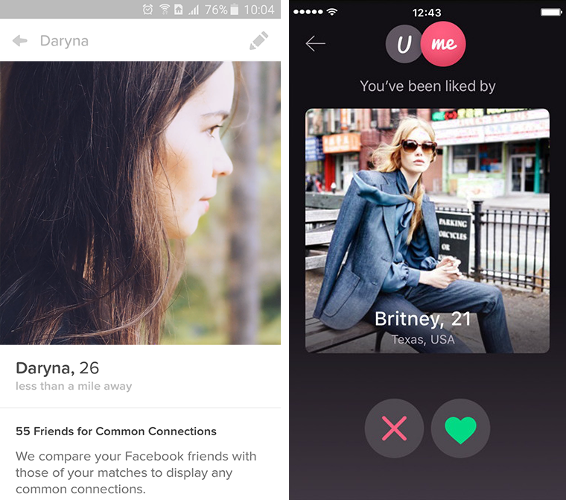
Фільтри
Замість того, щоб вручну шукати потенційних партнерів, клони Tinder надають користувачам дуже прості фільтри (місцезнаходження, стать, вік) і показують лише кандидатів, які їм відповідають. Хоча користувачі можуть не змогти знайти людей, які захоплюються їхніми улюбленими фільмами, цього достатньо для початкового відбору:
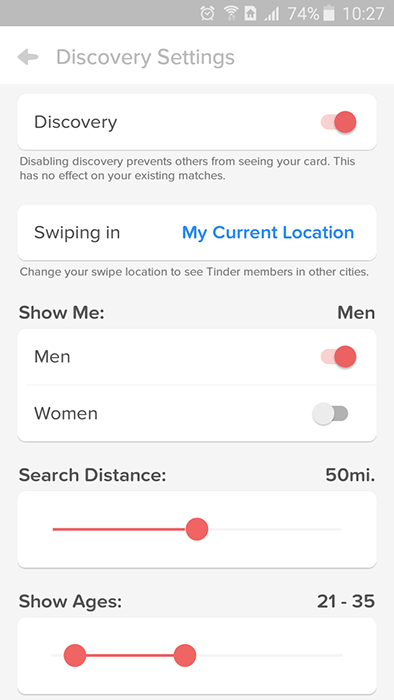
Оскільки почати використовувати додатки, схожі на Tinder, дуже просто, у них є великий потенціал стати звичкою.
Суперечність
Ми вирішуємо, чи є людина привабливою, за лічені секунди, і Tinder використав це загальне знання для створення простого алгоритму: проведіть вліво, якщо вам не подобається фото людини, і проведіть вправо, якщо вас це цікавить. Все так просто: ваш розум вирішує, а пальці проводять. Тільки після того, як двоє людей провели вправо на фото один одного, вони можуть почати спілкуватися. Цей підхід усуває плутанину, коли вам пише хтось, хто вам абсолютно не цікавий, і забезпечує більшу безпеку та конфіденційність.
Ось як виглядає проведення в нашому додатку UME, схожому на Tinder:
Події в реальному часі
Ера електронної пошти давно минула. FoMO чи ні, люди хочуть отримувати сповіщення, якщо відбувається щось важливе. Саме тому події в реальному часі є обов'язковими для додатку, схожого на Tinder. Коли користувач отримує новий матч або повідомлення, сервер отримує сповіщення, і в залежності від того, чи користувач онлайн чи офлайн, він або вона миттєво отримує push-сповіщення або електронний лист.
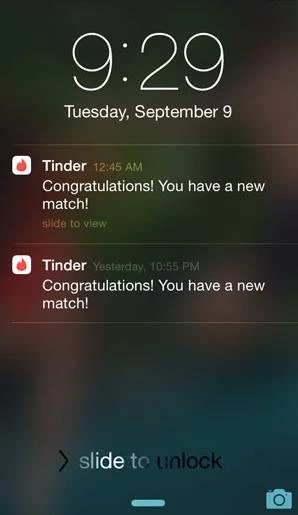
Перегляньте кейси додатку UME з нашого портфоліо, щоб дізнатися більше про події в реальному часі.
Платні функції
Різні додатки, схожі на Tinder, пропонують різні функції для платних користувачів. Наприклад, Tinder пропонує:
- Досвід без реклами.
- Можливість повернути свій останній свайп, якщо ви випадково провели вліво на когось, хто вам насправді подобається.
- Зміна вашого місцезнаходження, якщо ви хочете зустріти когось з іншого міста чи країни.
- Більше лайків (безкоштовні користувачі мають близько 100 свайпів за 12 годин).
Якщо ваш додаток, схожий на Tinder, має функцію оцінювання, ви також можете монетизувати її, надаючи можливості залишатися на вершині списку. Інші додатки, схожі на Tinder, роблять можливість надсилання повідомлень топ-користувачам платною функцією.
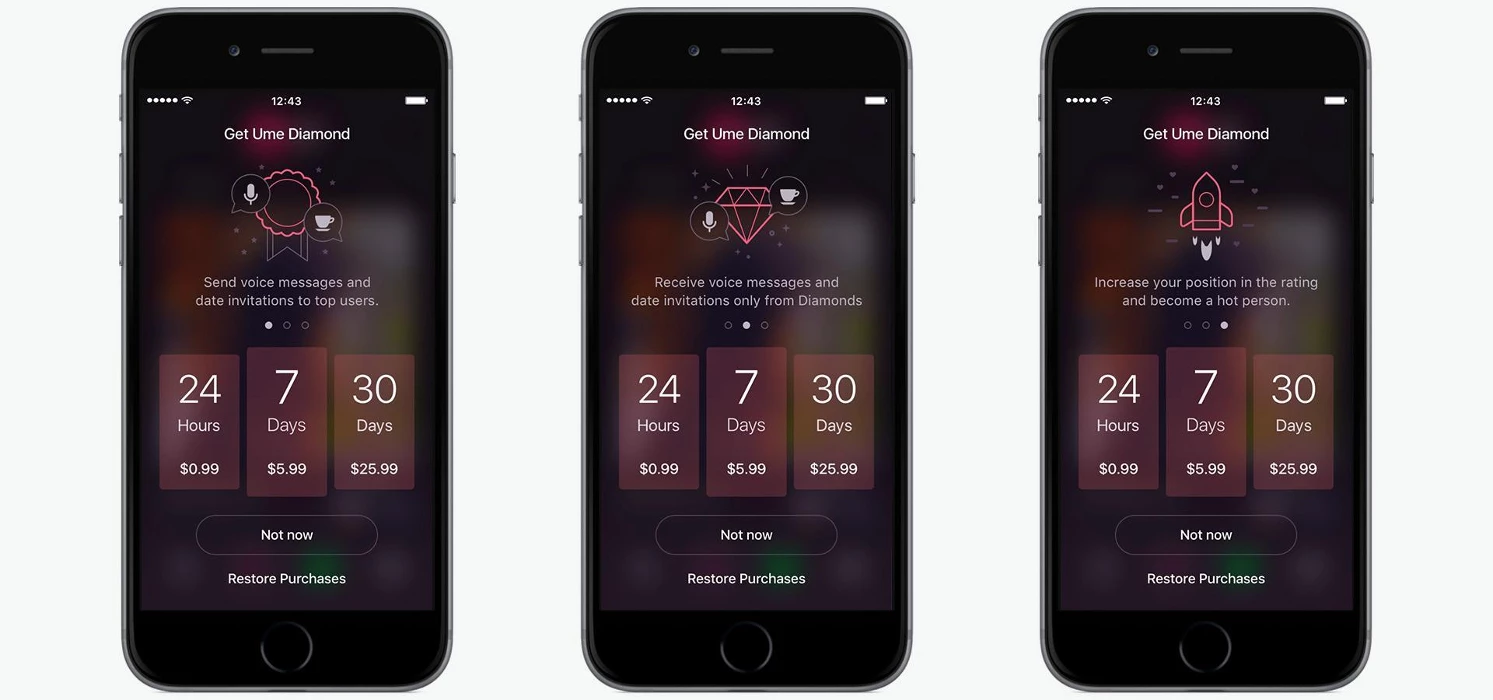
Вартість розробки, схожої на Tinder
Тепер, коли ви дізналися більше про основні функції, давайте подивимося, скільки коштує розробка додатку, схожого на Tinder:
- Дизайн — близько 200 годин, $3.5–5К
- Мобільний додаток для однієї платформи (Android або iOS) — близько 350–500 годин, $10–15K
- API — 350–400 годин, $10-12К
Загальна вартість створення додатку, схожого на Tinder, для однієї платформи становитиме близько $25-30K. Звичайно, це приблизні розрахунки, і остаточна вартість розробки додатку Tinder залежатиме від масштабу та специфіки проекту.
Студія stfalcon.com має досвід у розробці вражаючих MVP для стартапів і з радістю допоможе вашому продукту стати вірусним.

